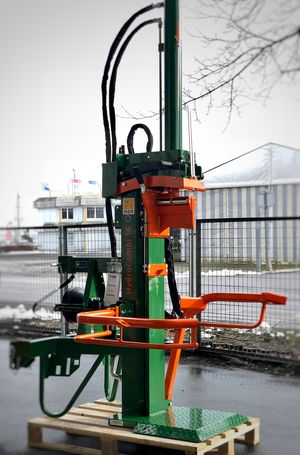KANBrief 1/18

Serious injuries frequently occur during the processing of firewood, owing to persons reaching into the sawing or splitting zone. In order to reduce the incidence and severity of accidents, the standards for wood splitting machines and circular saws used for this purpose have been revised. The revision work was based upon discussions held between experts and moderated by KAN, and accident investigations conducted by the Social insurance for agriculture, forestry and landscaping (SVLFG).
The existing standards governing wedge splitters (EN 609-1:1999+A2:2009) and circular sawing machines for firewood (EN 1870-6:2010-06) consider only the operation of these machines by a single person. The SVLFG's analysis of the incidence and severity of accidents over several years revealed that further persons are involved in the processing cycle for transport of the wood to and from the machine, and are consequently exposed to a risk of injury. The aim of the revision was therefore to consider the safety not only of the machine operator, but also of other persons who may be working in the vicinity of the machines.
A further aim was to make the work process safer and more ergonomic and to permit straightforward and functional operation of the machines. Cooperation with manufacturers enabled the newly defined requirements and the feasibility of their application to be tested in advance.
On wedge splitters which split vertically, in particular, reliable fixing of the workpiece was found to be of crucial importance (Figure page 15). Wood is a natural product, and each piece to be split is formed differently. When a workpiece cannot be fixed properly for the splitting process, a risk always exists of the operator or a third party reaching into the immediate danger zone to steady it – with potentially severe consequences. For this reason, it was important for requirements for safe fixing of the workpiece to be defined, and defeating of two-hand controls to be prevented.
It must also be ensured that only tools that can be used safely are actually used. The equipment for receiving, securing and splitting the wood must satisfy the necessary requirements for safeguarding pinch and shear points. Potential blockages and flying wood chips must also not be allowed to present a hazard. In addition, it was important for the safety distances on horizontal splitters to be redefined.
On circular sawing machines for firewood, it was found that the zone in which the log is fed to the saw by means of a rocker (pivoting log carriage) or sliding table must be safeguarded more effectively. Direct access during the sawing process to the point at which the saw projects from its shroud must be prevented by means of a protective device.
For the types of machine governed by the two standards, the stability of the machine is an important aspect, particularly since these machines are not used in workshops. Safe transport is also a significant factor. New, additional ergonomic requirements were defined to permit safe and straightforward use of the machines.
Since different types of machine exist, the decision was taken during the standards development work to implement the formulated requirements separately for the respective machine types:
The requirements resulting from the discussions between the experts and from the accident data were overwhelmingly implemented in German standardization activity. EN 1870-6 still exhibits certain discrepancies; it is hoped however that these will be corrected shortly.
Marc Löwer